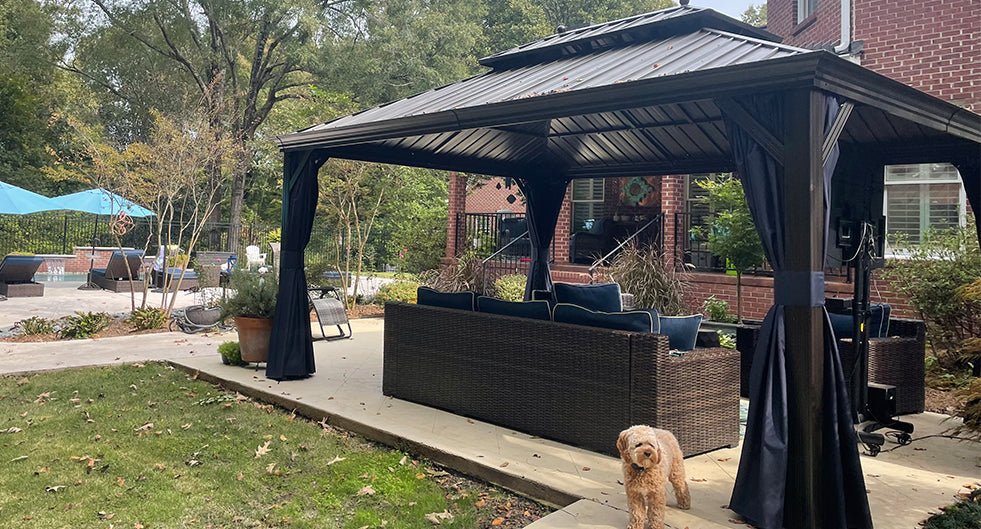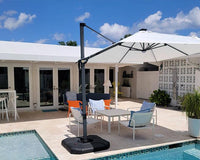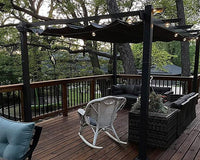Choosing between an aluminum and a wood gazebo isn't just about looks; it’s about understanding how each material performs in your climate, how much maintenance you're willing to do, and the overall vibe you're aiming for. There’s no single "best" answer, but there's definitely a best answer for you.
The Case for Aluminum: Sleek, Modern, and Low Maintenance
Aluminum gazebos have become incredibly popular, and for good reason. They offer a contemporary, clean look that fits really well with modern home designs and minimalist landscaping. One of their biggest selling points is durability combined with low maintenance.
Think about our varied American climates. Aluminum is naturally rust-resistant, which is a huge plus if you live in a humid area, near the coast with salty air, or anywhere that gets a lot of rain or snow. You won't be dealing with rot, warping, or insect infestations like you might with wood. Most aluminum gazebos come with a powder-coated finish, which adds another layer of protection against the elements and prevents fading from the sun. This means less work for you – a simple hosing down a couple of times a year is usually all it takes to keep it looking sharp. They are also relatively lightweight compared to wood, which can sometimes make installation a bit easier, though proper anchoring is still crucial.
The Allure of Wood: Classic Charm and Natural Beauty
There's an undeniable warmth and classic appeal to a wood gazebo. It evokes a sense of tradition and blends beautifully with natural surroundings, whether you have a lush garden or a more rustic backyard setting. The scent of cedar or pine on a warm day is something aluminum just can't replicate.
Wood offers incredible versatility in design. You can stain it to match your deck, paint it to complement your house, or let it weather naturally to a silvery gray (if it’s a suitable wood type like cedar). Popular wood choices include cedar, known for its natural resistance to rot and insects, and pressure-treated pine, which is more budget-friendly but will require more diligent maintenance to prevent decay. A wood gazebo often feels more substantial and can be more easily customized with built-in benches, planters, or intricate detailing. It truly becomes a handcrafted feature of your yard.

Durability and Weather Resistance: A Head-to-Head
Here, the distinctions really come through. Aluminum, as stated, is a winner at handling moisture and insects. Quality aluminum frames can withstand windy conditions if properly secured, and they won't buckle under heavy snow loads if designed to. Powder coat repels scratches and corrosion.
Wood's durability is more a function of the wood species and the maintenance given. Cedar and redwood have a natural better resistance. All wood, however, will suffer damage from moisture with time if left unsealed. This needs to be periodically sealed, stained, or painted to prevent rot, mildew, and infestation by insects, especially in humid climates or where temperature fluctuates greatly. Wood can also warp, crack, or splinter with time and exposure if not well taken care of.
Maintenance: How Much Time Do You Want to Spend?
Your lifestyle and how much time you're willing to dedicate to upkeep should heavily influence your decision. This is often the deciding factor for many homeowners.
Aluminum gazebos are the clear winner if low maintenance is high on your priority list. Aside from occasional cleaning, they pretty much take care of themselves. You won't be spending your weekends sanding, staining, or treating for pests.
Wood gazebos require a more hands-on approach. To keep them looking their best and structurally sound, you'll need to:
- Regularly inspect for any signs of damage, rot, or insect activity.
- Clean it annually to remove dirt, mildew, and pollen.
- Re-seal or re-stain it every few years, depending on your climate and the wood type. This protects the wood from moisture and UV damage.
If you enjoy a bit of DIY and don't mind the upkeep, the beauty of wood can be well worth the effort.The specific cleaning methods vary between materials, but proper maintenance ensures your gazebo remains a beautiful focal point in your outdoor space for years to come.

Cost Considerations: Upfront vs. Long-Term
Generally, aluminum gazebos can cost a bit more upfront for the same size and quality, especially for higher-end models with deeper frames and heavy finishes. But their minimal maintenance needs result in fewer long-term fees on sealants, stains, and potential repairs.
Wood gazebos will be cheaper in the short term, particularly if you utilize pressure-treated pine or a simpler kit. Just be certain to include the long-term cost of maintenance materials and the value of your time spent in keeping it up. In several years, a wood gazebo could be more costly in total when you account for these long-term expenses. Cedar will be more expensive initially than pine, but could save you money on maintenance down the line.
Aesthetics and Customization: Defining Your Style
Aluminum offers a sleek, often contemporary or transitional style. Colors are usually limited to what's offered by the manufacturer (typically blacks, bronzes, grays), but the designs can be quite elegant. Customization might be more about adding curtains, lighting, or furniture than altering the structure itself.
Wood provides a broader aesthetic range, from rustic and traditional to more refined and custom-built looks. The ability to paint or stain wood means you have virtually limitless color options to match your home and landscape. It's also easier to modify a wood structure if you decide to add custom features later on. The natural grain and texture of wood are often seen as a key aesthetic advantage.

Choose the Right Gazebos for Your Home
Ultimately, the decision to choose an aluminum or a wood gazebo is about finding a balance between what's most important. If you're looking for a clean appearance with minimal maintenance and excellent weather protection, aluminum is an excellent choice. If you love the timeless beauty of natural wood, are willing to do regular upkeep, and like a bit more freedom to customize, wood could be your winner. Consider your area weather, your budget, and how many hours you can realistically spend on maintenance. Either way, a well-researched gazebo will certainly contribute to your outdoor living for years to come.




